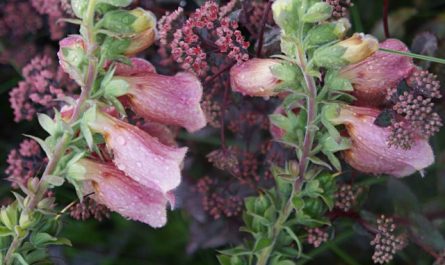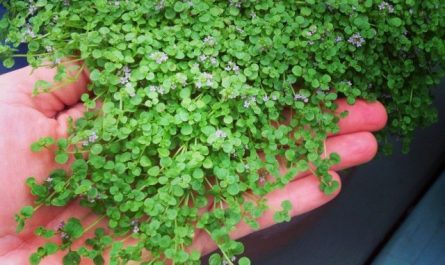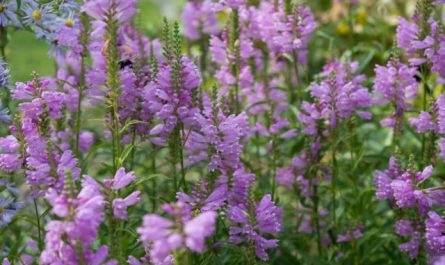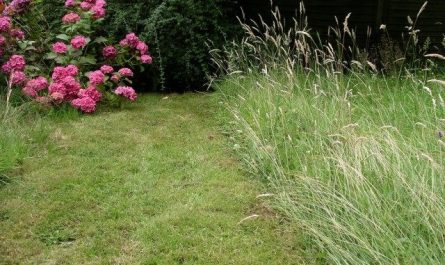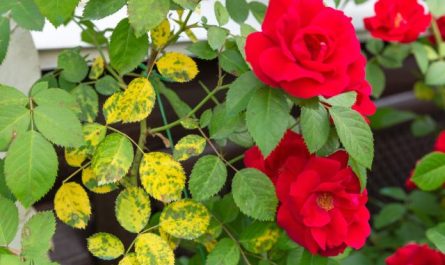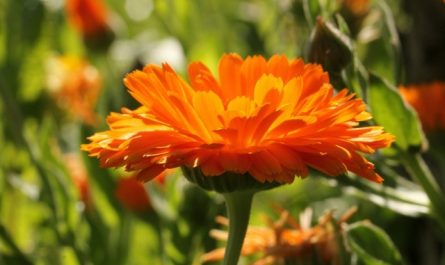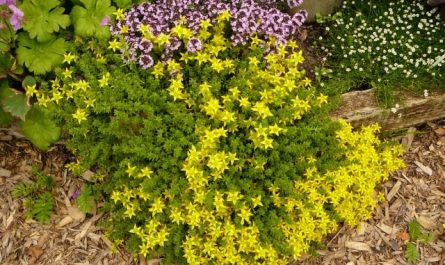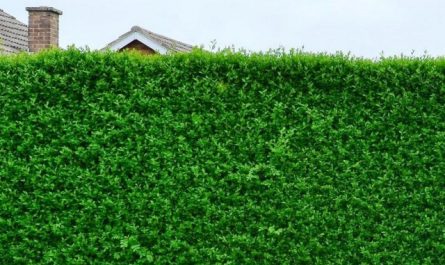Autumn is a great time to plant and replant perennial flowers, especially if it is time to divide them – they have grown so much that they have begun to lose their decorative value. Another reason to divide perennials in a flower bed is to get several plants instead of one. And autumn propagation by division has a significant advantage over spring – the planted divisions adapt to a new place of residence before winter, and in the spring they actively begin to grow and bloom already in the first season. We offer readers a list of 20 perennials that are best divided in the fall.

1. Astilbe
Astilbe is divided only if flowering has begun to decline. It can be divided without digging, part of the plant can be left in place, adding fresh soil to it. The rhizome of astilbe grows upward and eventually ends up on the surface, receiving insufficient moisture and risking freezing in winter. An old rhizome that is too thick cannot provide the plant with lush flowering.
Astilbe is a “water drinker”, it should be planted where it can get enough moisture. It is not afraid of shady places and close groundwater. After planting, it must be mulched. When planting in the fall, more organic matter is added – a bucket of peat and humus per 1 m² and a little (1/4 cup per 1 m²) of superphosphate or autumn fertilizer.
The bush is divided with a sharp knife or shovel so that each division has 5-6 buds, and planted at a distance of 30-50 cm, depending on the size of the adult plant. The plantings are watered abundantly and mulched for the winter.
2. Brunner
Brunnera can grow in one place for 15 years or more. But if you want to propagate it, you can do it in the spring or fall. Fall division has the advantage because cool, damp weather is the best time for new roots to grow.
Brunnera’s rhizomes are located close to the surface, it is enough to cut off several divisions on the periphery of the bush with a shovel and transplant to a new place in soil filled with humus. New plantings require watering if the weather is dry.
It is better to dig up the old bush completely, separate the young parts of the rhizome with several buds, and simply throw away the old parts.
Oddly enough, the varietal Brunnera macrophylla is less demanding to the soil composition. The species Brunnera sibirica prefers moist clay soil with a slightly acidic reaction in partial shade.

3. Phlox
Phloxes are divided only when they are older than 5 years, and this should be done no later than mid-September. They can be divided with or without digging. When dividing without digging, only part of the bush is separated and divided so that each division has 5-6 shoots. A nutrient mixture is added to the old part.
When dividing with digging, carefully dig up the bush, trying to preserve the lump and divide it into parts with a sharp shovel, also leaving 5-6 shoots on each division. If you need a lot of planting material at once, you can divide it smaller, but in this case flowering will be delayed by 2-3 years.
Phloxes are very flexible and can be divided even in a flowering state, but before planting the divisions, it is necessary to remove the inflorescences and shorten the stems by half. The divisions should be planted in fertile soil in the sun, watered and mulched at first to retain moisture.
4. Daylilies
Dividing without digging is the most gentle and least risky way to divide daylilies. It is almost impossible to destroy the plant this way, because part of the old bush remains in place and gets fresh fertile soil and space for growth. And the separated parts are moved to a new place with a lump of earth.
This is done as follows: visually determine the place where the leaf rosettes form a gap, and with a sharp shovel cut the bush in this place. Dig out the part intended for transplantation with a lump. Sprinkle the cut with crushed coal, fill the hole in the ground with a fertile mixture: peat, humus and sand in a ratio of 1:1:1 + superphosphate or autumn fertilizer, if you have not fertilized the daylily yet.
The separated part (or parts) are planted with a lump in a prepared place. The holes for daylilies should be made larger, for example, 50×50, because they can grow in one place, provided they are adequately cared for, for 5 to 10 years, and filled with a nutrient mixture with fertilizer.
It is better to postpone dividing the bushes with complete digging until spring, since the damage is greater, and the daylily will need more time to adapt.
Daylily divisions that are too small – with one rosette of leaves – will most likely not bloom next year. Therefore, if you want to quickly get flowering bushes in a new place, do not divide the daylily too small, it is better for the divisions to have 2-3 rosettes.

5. Hosts
Hostas are divided in the fall in the same way as daylilies – without digging and later than a month before the first frost.
6. Black cohosh
Cimicifugas are divided at the very beginning of autumn, preferably without digging, otherwise the bush may freeze in winter. With a sharp shovel, cut off part of the bush with 3-4 shoots and plant it in a new place in partial shade with fertile soil, mulch with peat or humus. If autumn is dry, you need to carefully monitor the soil moisture, preventing it from drying out. For the winter, it is better to cover new plantings with spruce branches.
7. Body
Bergenias need to be divided every 5-6 years, otherwise the middle of the bush becomes bare, the old parts of the rhizome die off and the leaves grow only on the periphery. The rhizome is dug up, the young parts with buds are cut into several divisions with a sharp knife, and the old parts without buds and leaves are thrown away.
They are planted in a new place in partial shade on previously prepared soil. Two buckets of humus and half a glass of autumn fertilizer are added to it for each m². The distance between the divisions is 40 cm. At first, they are watered abundantly.
Bergenia can also be planted in the sun, but then it will require more frequent watering.
8. Dicentra
Dicentras do not like transplantation, but they are divided once every 5-7 years, otherwise the rhizome grows out, and the plant may simply disappear. It is necessary to work with rubber gloves, dicentra is a poisonous plant, its juice has a nerve-paralytic effect.
The rhizome of the dicentra is very fragile, so you need to dig it up with a pitchfork, very carefully. After digging, also carefully wash it and put it to dry, so that you can not be afraid of breaks in inappropriate places.
Then the rhizome is divided into 8-12 cm sections with 3-4 buds and planted in a prepared place in partial shade with fertile soil of slightly acidic reaction and mulched.

9. Purchased
Solomon’s seals are divided quite often – once every three years, because their rhizome grows quite quickly and shoots are formed only on the periphery, and the center of the bush remains bare. The rhizome is shallow and the process of digging and dividing resembles irises, but Solomon’s seal has many more small suction roots.
Each division should have 3-4 renewal buds. Solomon’s seal is a fairly unpretentious plant and does not require special care. But in nature, it grows on moist fertile forest soils and will expect the same from you.
Solomon’s seal is an ideal plant for the shade; in the sun it will burn and wither. And although it needs enough moisture, it does not tolerate excessive and stagnant moisture.
10. Liverwort
Liverwort should be divided no later than the first ten days of September. It is divided once every 4-5 years. The bushes are carefully dug up, washed and divided into parts with 2-3 buds.
The soil is fertile, coniferous-deciduous with the addition of sand, in the shade. Liverwort is a delicate but hardy plant. But after dividing it, you still need to pay maximum attention to it: mulch the plantings and do not allow them to dry out.
11. Iris
Dividing irises is easy and enjoyable. Even a child can do it. Their rhizomes are located right on the surface, just slightly lift them with a pitchfork or shovel and you can carefully pull them out.
After digging, the rhizomes are inspected, old, rootless and leafless, dead and unhealthy parts are cut off, sprinkling the cuts with crushed coal or ash. For this purpose, I take the crumbs left in the bag from barbecue coal. If the crumbs are too large, they need to be additionally crushed. You can sprinkle with ash.
The suction roots are cut to healthy tissue or a length of 10 cm. The fan of leaves is cut into a “house” shape so that water does not get inside the bush at a height of 10-20 cm. This will reduce evaporation and speed up the survival rate.
If the leaves are healthy, they can be composted, and the rhizome cuttings must be burned. The prepared divisions are dried in the sun for several days and planted in a permanent place at intervals of 40-60 cm so that the back of the division faces north, and the thick rhizome is fully illuminated by the sun.
First, make a shallow oblong hole, then pour a ridge of earth in the middle, place the rhizome on it, spread the roots out to the sides, cover with earth and water the planting.
The soil should be prepared in advance: for each square meter of land, add one or two buckets of humus, a bucket of sand, a couple of glasses of ash and half a glass of superphosphate or autumn fertilizer. The place should be as sunny as possible. In partial shade, irises will develop well, but bloom poorly or not at all.

12. Verbeynik
You can divide loosestrife at any time, including in the fall. It is not necessary to dig up the entire bush; it is enough to separate the peripheral parts with a sharp shovel and add fresh soil in their place and in the center of the clump.
New plantings need to be kept moist.
13. Heuchera and Heucherella
Heucheras and heucherellas are very easy to divide and take root well. Use a sharp spatula to separate a division with 2-3 rosettes, dip it in root powder if the roots were damaged during division, and plant it in a new place. Your only concern is that the soil does not dry out.
14. Perennial Rudbeckia
They are divided after full flowering, late in the fall, when the leaves are already starting to fall from the trees. It is more reliable to propagate by seeds, but there are two problems here: they quickly lose their germination, so it is better to sow them immediately after harvesting before winter and, if you collect seeds from your bushes, you cannot guarantee the purity of the variety due to cross-pollination.
Therefore, if you want to preserve a pure variety, you need to carefully dig up a 3-4 year old bush and divide it into parts with 2-3 rosettes. Do not make it smaller, small rosettes will take root worse and will not bloom soon. Considering that rudbeckia is a “young plant”, needs renewal and can fall out in winter – this is not in our interests. It is better to get 2-3 fully developed bushes than 10 small divisions.
15. Echinacea
Echinacea is propagated by division in the fall according to the same rules as rudbeckia.
16. Peony
Peony is one of the plants that is not so easy to divide, but autumn division is optimal. With spring division, the bush takes root worse and generally develops longer.
I am not a big expert in this matter, because I have divided peonies only a few times. They can grow in one place for decades, and there is no point in disturbing them unnecessarily. And it is not so easy to dig up a powerful rhizome without damage. In any case, you should not divide peonies more often than once every 5 years.
The rhizome is carefully dug up, washed, slightly dried and divided into parts with 2-3 renewal buds. The leaves are cut off, leaving stumps of 10-15 cm. Old, rotten and damaged roots are cut out and thrown away, the cuts are sprinkled with crushed coal. Before planting, it is good to hold the rhizome for a while in a solution of potassium permanganate.
The hole is dug deep, no less than 50 by 50 cm, it is better to prepare it in advance. Fertile soil is made from humus, peat, sand and garden, turf or leaf soil (1:1:1:1). It is filled with a couple of glasses of ash and mixed well.
At the bottom, make drainage from pebbles or broken shards, pour in a little of the prepared mixture, then a glass of superphosphate or autumn fertilizer, then another layer of the mixture and tamp. Then place the peony rhizome and fill with the rest of the mixture so that the buds are 3-5 cm (but not more!) below the soil level, and water well. Make sure that the rhizome is not “pulled” deep.
Fertilizers are placed at the bottom of the hole to stimulate the peony to develop deep roots, which makes it virtually invulnerable to drought and frost. If you add fertilizers to the surface layer of the soil, it will grow a shallower and wider root system and suffer from a lack of moisture during drought. And such bushes age earlier, because over time the rhizome grows and becomes closer to the surface. For the same reason, peonies should be watered rarely, but abundantly.

17. Geranium
Garden geraniums take root very easily (I find it strange to read from article to article that they do not like transplanting). They are usually planted in clumps, so the selected area in the semi-shade is dug up and a couple of buckets of humus per square meter are added to the digging. If the soil is heavy, sand should also be added.
There are many types of geranium, and since their requirements for moisture and soil structure differ, it is better to check the conditions for each specific type. Some, like large-rhizome, have a creeping rhizome, while others, like meadow geranium, have a bush. Creeping rhizomes are divided into parts with a rosette of leaves and buds on each, and the old parts are thrown away. The bush is divided with a knife or by hand, as geranium roots are not very powerful.
The rhizomes are laid out on the surface and sprinkled with soil. The cuttings are planted in holes slightly larger than the size of the root system, at the bottom of which a spoon of superphosphate or autumn fertilizer is poured.
18. Sedum
Sedums can be propagated at any time, they take root very easily, especially creeping forms. But it is necessary to do this once every 4-6 years. In caustic sedum, false sedum and other ground cover species, shoots with adventitious roots are separated, they are laid out on the surface of loose soil and sprinkled with earth so that the top of the shoot is above the surface.
Bush sedums are divided into parts with several shoots and planted in holes twice as big as the root ball with a nutrient mixture prepared from ordinary garden soil, sand and humus in a ratio of 1:1:1 with the addition of a good portion of wood ash. No additional fertilizers need to be added.
The plantings are moistened and care is taken to ensure that the soil does not dry out during the rooting period, which lasts 2-3 weeks. Sedums should be planted at least a month before the onset of cold weather.
19. Goryanka
Unfortunately, epimediums are not very common plants in our country. This is an ideal ground cover plant that is almost never sick, retains winter-green leaves that are renewed in May-June, and also blooms with elegant small flowers in the spring.
Epimediums grow in one place for 10 years or more, but if you want to propagate them, you can carefully divide the rhizomes (the division points are clearly visible in the fall) and plant them in fresh, carefully prepared soil with the addition of humus in partial shade.
The epimedium can be planted in the trunk circle of an apple tree; it will not compete with the tree. An important condition is to maintain soil moisture without over-watering.
20. Hellebore
Hellebore is a long-lived plant, it can grow in one place for up to 25 years, it does not like transplantation. But if you want to propagate it, now is the best time. You can carefully divide the bush without digging, as described for daylilies, or carefully dig it out completely, wash the roots and divide with a sharp knife.
The division should have 2-3 buds. Also, the beginning of autumn is a good time to transplant hellebore seedlings to a permanent place. Due to the rapid loss of seed germination, seed propagation is difficult, but hellebore reproduces well by self-seeding.
The seedlings are carefully dug up with a lump of earth and transplanted into turf soil with a slightly alkaline or neutral reaction. Hellebores are excellent groundcover plants for the trunk circles of fruit trees.
Don’t forget to wear rubber gloves – hellebore is poisonous!



